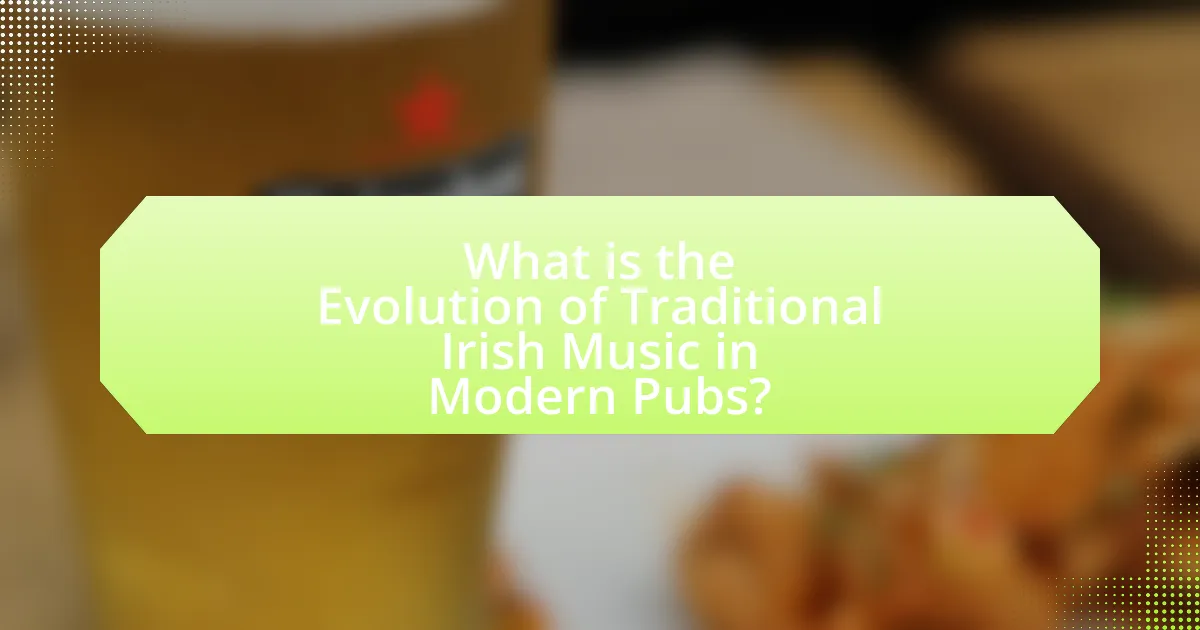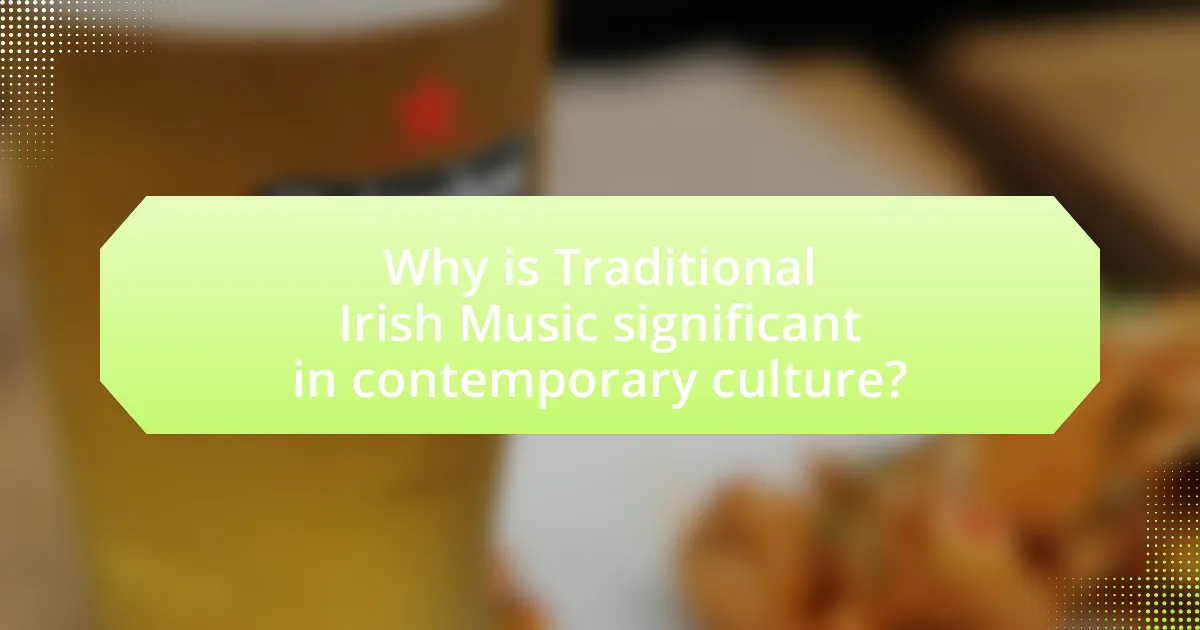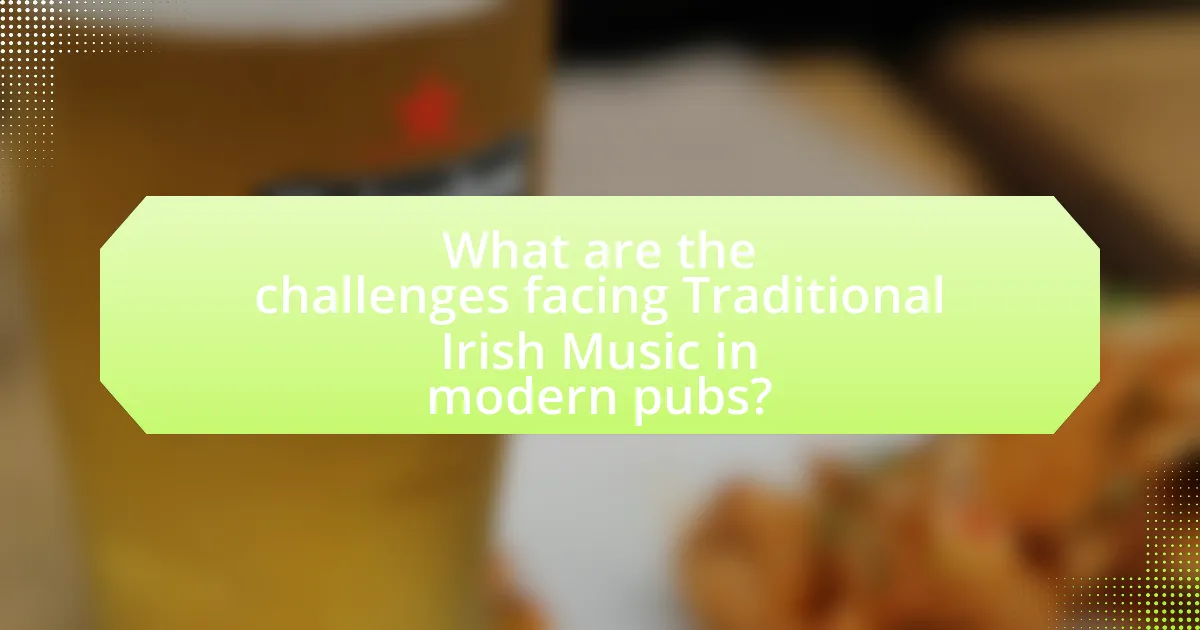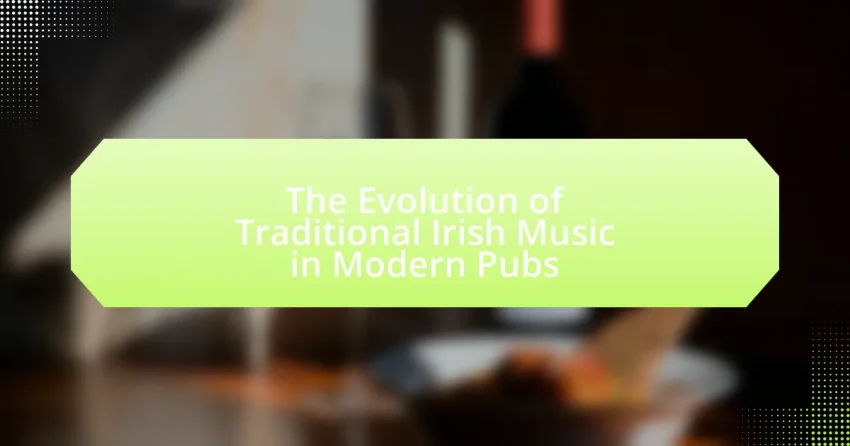The article examines the evolution of traditional Irish music within modern pubs, highlighting its transition from rural gatherings to urban settings where it now blends with contemporary genres like rock and pop. It discusses the historical influences that have shaped this music, including the Gaelic cultural revival and the impact of emigration, as well as societal changes that have led to a more diverse sound. The role of modern pubs as vital venues for live performances and community engagement is emphasized, alongside the challenges faced by traditional musicians in a commercialized environment. Additionally, the article explores how traditional Irish music fosters cultural identity and community connections while adapting to modern musical trends.

What is the Evolution of Traditional Irish Music in Modern Pubs?
The evolution of traditional Irish music in modern pubs reflects a blend of historical authenticity and contemporary influences. Traditional Irish music, characterized by instruments like the fiddle, tin whistle, and bodhrán, has transitioned from rural gatherings to urban pub settings, where it now often incorporates modern genres such as rock and pop. This shift is evidenced by the rise of fusion bands that combine traditional melodies with contemporary rhythms, attracting a diverse audience. Additionally, the use of technology, such as amplification and digital streaming, has expanded the reach of traditional Irish music, allowing it to thrive in modern pub culture while maintaining its roots.
How has Traditional Irish Music changed over the years?
Traditional Irish music has evolved significantly over the years, transitioning from purely oral traditions to a more commercialized and globalized form. Historically, traditional Irish music was passed down through generations in informal settings, often featuring instruments like the fiddle, tin whistle, and bodhrán. In the 20th century, the introduction of recording technology and the rise of folk revival movements led to increased exposure and adaptation of these musical styles, incorporating elements from other genres such as rock and pop. This blending has resulted in a more diverse sound, appealing to wider audiences in modern pubs and festivals. Additionally, the globalization of music has facilitated collaborations with international artists, further transforming the traditional sound while maintaining its cultural roots.
What historical influences have shaped Traditional Irish Music?
Traditional Irish Music has been shaped by various historical influences, including the Gaelic cultural revival, British colonialism, and the impact of emigration. The Gaelic cultural revival in the late 19th and early 20th centuries emphasized the importance of Irish heritage, leading to a resurgence in traditional music. British colonialism introduced new musical forms and instruments, such as the fiddle and the flute, which were integrated into Irish music. Additionally, emigration, particularly during the Great Famine, spread Irish music globally, influencing and being influenced by other musical traditions, thus enriching its evolution.
How have societal changes impacted the evolution of this music?
Societal changes have significantly influenced the evolution of traditional Irish music in modern pubs by integrating contemporary themes and diverse musical styles. The rise of globalization and increased cultural exchange have led to the incorporation of various genres, such as rock and pop, into traditional Irish music, creating hybrid forms that appeal to broader audiences. Additionally, the shift towards a more inclusive society has encouraged the participation of musicians from different backgrounds, enriching the musical landscape. For instance, the popularity of Irish music festivals has fostered collaboration among artists, blending traditional elements with modern influences, which reflects changing social dynamics and tastes.
What role do modern pubs play in the evolution of this music?
Modern pubs serve as vital venues for the evolution of traditional Irish music by providing a space for live performances, fostering community engagement, and facilitating the blending of musical styles. These establishments often host regular sessions where musicians gather to play, allowing for the transmission of traditional tunes and the introduction of contemporary influences. Research indicates that the rise of pub culture in Ireland has led to a resurgence in interest in traditional music, with venues like The Cobblestone in Dublin becoming iconic for their role in preserving and innovating the genre. This dynamic environment encourages collaboration among musicians of varying backgrounds, contributing to the ongoing evolution of the music.
How do modern pubs differ from traditional venues for Irish music?
Modern pubs differ from traditional venues for Irish music primarily in their atmosphere and approach to live performances. Traditional venues often emphasize an intimate setting with acoustic performances, fostering a close connection between musicians and the audience, while modern pubs frequently incorporate amplified music, larger crowds, and a more commercialized environment. This shift reflects broader changes in social dynamics and entertainment consumption, where modern establishments may prioritize a diverse range of entertainment options, including DJs and themed nights, over the singular focus on traditional Irish music. Additionally, modern pubs often cater to a wider demographic, including tourists, which can dilute the authenticity of the traditional music experience that is typically preserved in more dedicated venues.
What unique features do modern pubs offer to musicians and audiences?
Modern pubs offer unique features such as advanced sound systems, dedicated performance spaces, and interactive audience engagement tools that enhance the experience for both musicians and audiences. These establishments often invest in high-quality audio equipment to ensure clear sound, which is crucial for live performances. Additionally, many modern pubs have designated areas for musicians, allowing for better acoustics and visibility, which fosters a more intimate atmosphere. Interactive features, such as live streaming of performances and audience participation through apps or social media, further engage patrons and create a dynamic environment. These elements collectively contribute to a vibrant music scene, making modern pubs essential venues for the evolution of traditional Irish music.

Why is Traditional Irish Music significant in contemporary culture?
Traditional Irish music is significant in contemporary culture because it serves as a vital link to Ireland’s heritage and identity while fostering community and social cohesion. This genre has evolved to remain relevant, often being performed in modern pubs where it attracts diverse audiences, thereby promoting cultural exchange. The music’s incorporation into contemporary settings, such as festivals and global events, highlights its adaptability and enduring appeal, reinforcing its role in preserving Irish traditions. Additionally, studies show that participation in traditional music activities can enhance social bonds and cultural pride among communities, further solidifying its importance in today’s society.
What cultural values does Traditional Irish Music represent today?
Traditional Irish music today represents values of community, heritage, and resilience. This genre fosters social connections through communal gatherings, where people come together to share stories and experiences, reinforcing a sense of belonging. Additionally, it embodies cultural heritage by preserving historical narratives and traditional practices, often passed down through generations. The resilience of this music is evident in its ability to adapt and thrive in modern settings, such as pubs, where it continues to engage audiences and maintain its relevance. The enduring popularity of traditional Irish music in contemporary culture highlights its role in celebrating identity and continuity within the Irish community.
How does this music foster community and connection among listeners?
Traditional Irish music fosters community and connection among listeners by creating shared experiences that encourage social interaction and cultural exchange. In modern pubs, live performances of this music often bring together diverse groups of people, facilitating conversations and camaraderie. The communal aspect is reinforced by the participatory nature of the music, where audience members frequently join in singing or dancing, thus enhancing feelings of belonging. Research indicates that music can strengthen social bonds; for instance, a study published in the Journal of Music Therapy found that group music-making activities significantly improved social cohesion among participants. This evidence supports the idea that traditional Irish music in pubs serves as a vital medium for fostering community connections.
What impact does Traditional Irish Music have on cultural identity?
Traditional Irish music significantly shapes cultural identity by preserving and promoting Irish heritage and community values. This genre serves as a medium for storytelling, reflecting historical experiences and social issues relevant to Irish society. For instance, traditional songs often recount tales of struggle, resilience, and celebration, fostering a sense of belonging among listeners and performers alike. Additionally, the revival of traditional music in modern pubs has reinforced communal ties, as these venues become spaces for cultural exchange and intergenerational interaction, thereby sustaining the musical tradition. The Irish Music Rights Organisation reported that traditional music events have increased participation in cultural activities, highlighting its role in maintaining and evolving cultural identity within contemporary contexts.
How does Traditional Irish Music influence modern musical genres?
Traditional Irish music significantly influences modern musical genres by introducing unique rhythms, melodies, and instrumentation that have been integrated into various styles such as folk, rock, and pop. The use of traditional instruments like the fiddle, tin whistle, and bodhrán has inspired contemporary musicians to incorporate these sounds into their compositions, creating a fusion that resonates with audiences. For example, bands like The Pogues and Flogging Molly blend traditional Irish music elements with punk rock, showcasing how these influences can shape new genres. Additionally, the storytelling aspect of Irish music has impacted songwriting across genres, emphasizing narrative and emotional depth in modern music.
What contemporary artists are blending Traditional Irish Music with other genres?
Contemporary artists blending Traditional Irish Music with other genres include Lisa Hannigan, who incorporates elements of folk and pop, and The Gloaming, known for their fusion of traditional Irish sounds with contemporary classical and jazz influences. Additionally, the band Beoga merges traditional Irish music with modern pop and electronic elements, showcasing the versatility of the genre. These artists exemplify the evolution of Traditional Irish Music by integrating diverse musical styles, thereby expanding its reach and appeal in modern settings.
How does the fusion of styles affect the perception of Traditional Irish Music?
The fusion of styles significantly enhances the perception of Traditional Irish Music by introducing diverse influences that broaden its appeal. This blending allows traditional elements to coexist with contemporary genres such as rock, pop, and jazz, making the music more accessible to a wider audience. For instance, artists like The Chieftains and The Pogues have successfully integrated modern sounds with traditional Irish instrumentation, resulting in a fresh interpretation that resonates with both younger and older generations. This evolution not only preserves the essence of Traditional Irish Music but also revitalizes it, ensuring its relevance in today’s musical landscape.

What are the challenges facing Traditional Irish Music in modern pubs?
Traditional Irish Music faces several challenges in modern pubs, primarily due to commercialization, changing audience preferences, and the impact of technology. Commercialization often leads to a dilution of authentic musical practices as venues prioritize entertainment value over cultural integrity. Changing audience preferences, particularly among younger patrons, can result in a decreased interest in traditional forms, favoring contemporary genres instead. Additionally, technology, such as digital music streaming and amplified sound systems, can overshadow live performances, making it difficult for traditional musicians to compete for attention and maintain their audience. These factors collectively threaten the preservation and appreciation of Traditional Irish Music in the pub setting.
How do commercial interests affect the authenticity of Traditional Irish Music?
Commercial interests significantly affect the authenticity of Traditional Irish Music by prioritizing marketability over cultural integrity. In modern pubs, the demand for entertainment often leads to the commercialization of music, where traditional forms are altered to appeal to broader audiences, resulting in a dilution of original styles and practices. For instance, the incorporation of pop elements or simplified arrangements can make the music more accessible but may stray from its authentic roots. This trend is supported by research indicating that venues often select music based on profitability rather than cultural significance, which can undermine the preservation of traditional techniques and storytelling inherent in the genre.
What pressures do musicians face in modern pub settings?
Musicians in modern pub settings face pressures such as financial instability, audience expectations, and competition from recorded music. Financial instability arises from low pay rates and inconsistent gig opportunities, which can hinder a musician’s ability to sustain a living. Audience expectations often include a demand for popular songs or specific genres, limiting musicians’ creative expression and forcing them to cater to crowd preferences rather than their artistic vision. Additionally, competition from recorded music and digital streaming services can diminish live performance attendance, as patrons may opt for the convenience of listening to music at home rather than going out to see live acts. These pressures collectively impact musicians’ livelihoods and artistic choices in the evolving landscape of traditional Irish music in pubs.
How can musicians maintain authenticity while appealing to modern audiences?
Musicians can maintain authenticity while appealing to modern audiences by blending traditional elements with contemporary styles. This approach allows artists to honor their cultural roots while also engaging listeners who favor modern sounds. For instance, incorporating modern instrumentation or production techniques into traditional Irish music can attract a wider audience without sacrificing the genre’s essence. Research indicates that artists who successfully merge these elements often see increased popularity and audience engagement, as evidenced by the rise of bands like The High Kings, who have revitalized traditional Irish music for new generations.
What strategies can be employed to preserve Traditional Irish Music in pubs?
To preserve Traditional Irish Music in pubs, implementing regular live music sessions featuring local musicians is essential. These sessions create an authentic atmosphere that encourages participation from both performers and patrons, fostering a community around the music. Additionally, establishing partnerships with music schools and cultural organizations can facilitate workshops and educational programs that engage younger generations, ensuring the transmission of musical knowledge and skills. Research indicates that venues that actively promote traditional music events see increased patronage and community involvement, reinforcing the cultural significance of the music. Furthermore, documenting performances and creating digital archives can help preserve the music for future generations, allowing for broader access and appreciation.
How can pub owners support the preservation of Traditional Irish Music?
Pub owners can support the preservation of Traditional Irish Music by hosting regular live music sessions featuring local musicians. These sessions not only provide a platform for artists to showcase their talent but also create an authentic atmosphere that attracts patrons interested in cultural experiences. Research indicates that venues that prioritize live traditional music can enhance community engagement and foster a sense of cultural identity, as seen in the success of pubs in cities like Dublin, where traditional music sessions have become integral to the local nightlife. By promoting these events, pub owners contribute to the sustainability of this musical heritage.
What role do music festivals play in promoting Traditional Irish Music?
Music festivals play a crucial role in promoting Traditional Irish Music by providing a platform for artists to showcase their talents and connect with audiences. These festivals often feature a diverse lineup of musicians, including both established and emerging artists, which helps to sustain and revitalize the genre. For instance, events like the Fleadh Cheoil na hÉireann attract thousands of attendees each year, fostering a communal appreciation for Traditional Irish Music and encouraging participation through workshops and sessions. This exposure not only enhances the visibility of Traditional Irish Music but also contributes to its preservation and evolution within contemporary cultural contexts.
What are some best practices for enjoying Traditional Irish Music in modern pubs?
To enjoy Traditional Irish Music in modern pubs, actively engage with the music by listening attentively and participating in sing-alongs. Engaging with the musicians and showing appreciation through applause or requests enhances the experience. Additionally, choosing a pub known for its authentic Irish music sessions, such as those featuring local musicians, ensures a genuine atmosphere. Research indicates that pubs with a strong community focus often provide a richer musical experience, as they foster connections between performers and patrons.
